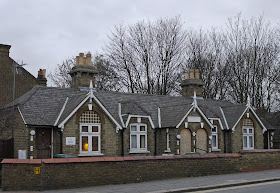Christchurch Spitalfields
Dinner in London offered an opportunity for some sort of a walk and I decided to progress my almshouses project. I have recently read Clive Berridge's invaluable The Almshouses of London and with the aid of the A to Z and the tube map I rough out an interesting itinerary.
I start from Liverpool St and walk along Brushfield St to Commercial Road. Spitalfields Market (which a plaque says was rebuilt for Queen Victoria's Jubilee in 1887) is on one side and the imposing Baroque Christchurch (1714-29, designed by Nicholas Hawksmoor) is almost opposite.
Puma Court is home to the Norton Folgate Almshouses. Two rectangular brick buildings divided by a narrow gated courtyard are now home to four two-bedroom flats. A plaque reveals that the buildings date from 1860 and were built to replace earlier ones of 1728 in Blossom St which were demolished to allow for road widening. The original 1860 accommodation was a single room for each resident, but successive renovations have improved on this.
From here I walked up Fournier St and along the celebrated Bangladeshi enclave of Brick Lane to then head east along Whitechapel St and then into Mile End Rd in search of one of London's many hidden gems: the Trinity Green Almshouses. They were designed by Sir Christopher Wren and date from 1695. They consist of two single storey ranges facing each other across a lawn, with a handsome chapel at the end. Each of the ranges has a triangular pediment on the centre.
At the end of each range, facing the street is a sort of gatehouse. The plaque contains the inscription that they were founded by the Corporation of Trinity House, on land provided by a Captain Henry Mudd, for "28 decay'd Masters and Commanders of Ships, or their widows". The nautical connection is displayed in the statue of a ship on the left hand side.
They were badly damaged in the war, but were subsequently restored and are now used as Council housing.
I now cheated and took the London Overground to Hoxton to see my next target: the former Ironmongers' Almshouses, now the Geffrye Museum, in Kingsland Road.
This delightful building was founded in 1714 by Sir Robert Geffrye, an Ironmonger and Mayor of London. The almhouses consist of a long central range with a pedimented chapel in the middle, and a shorter, separate, wing at each end. The buildings are laid out around a garden with trees and grass.
The site was sold to the London County Council in 1914 and turned into a museum. It now focuses on the history of the home. It is possible to see a restored almshouse at certain times. As it was already beginning to get dark I resisted the urge to go in and explore.
Instead I hopped back on the Overground to Seven Sisters and walked briskly north, pausing briefly to see Forsters Cottages of 1870. These have clearly been altered since Clive Berridge photographed them in that the two central front doors have now been boarded up. They were endowed by Josiah and Robert Forster and built in 1860. Berridge says they are the smallest surviving almshouses in London.
It was getting increasingly dark now and I walked urgently further north to my final target, the Drapers Almhouses in Bruce Grove. They date from 1870 and have the same basic shape as the Ironmongers' ones of 150 years earlier: a long range parallel to the road with a central chapel and separate wings at right angles.
In front is a very similar, and equally pleasant, grassy garden with trees.
A train from Bruce Grove returned me to Liverpool St and I arrived at the dinner venue right on time.
Conditions: cloudy, about 8 degrees.
Distance: I seem to have walked about five miles.
Rating: four stars. Three classic sets of Almshouses.









No comments:
Post a Comment